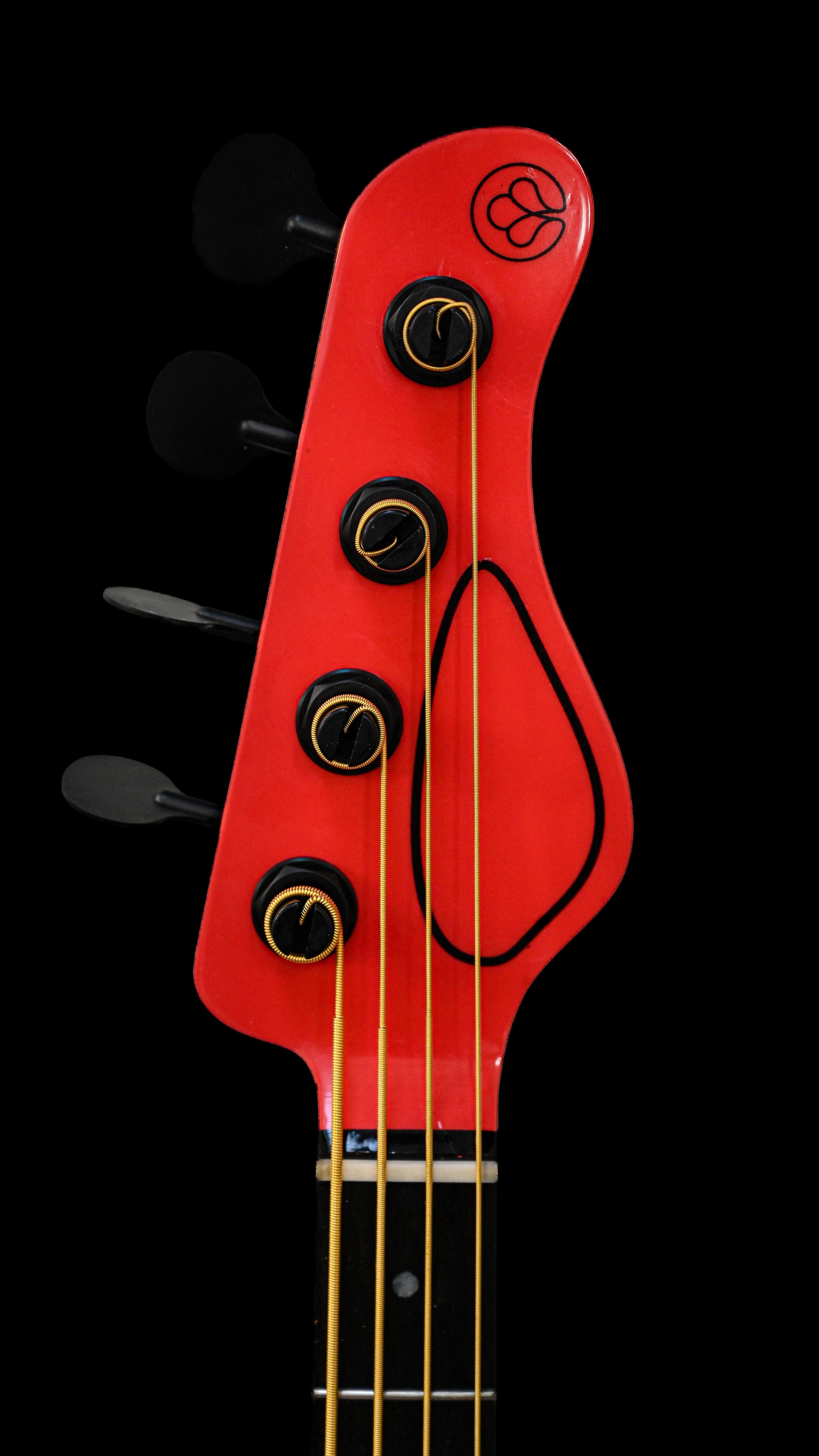Introduction
Strings are the beating heart of any stringed instrument, from the sharp snarl of an electric guitar to the deep growl of a bass. Despite their apparent simplicity, strings are complex components whose materials, construction, and dimensions directly affect tone, feel, and performance. Whether you're a player or a luthier, understanding the physics and construction of strings helps you make more informed choices—or build better instruments.
1. What Guitar and Bass Strings Are Made Of
Modern guitar and bass strings are made from various metal alloys, chosen for their tonal characteristics, durability, and feel. Each material brings its own sonic signature and physical properties:
-
Plain Steel: Used for unwound strings across both electric and acoustic guitars, this high-tensile steel wire is known for its bright tone and excellent sustain. It offers a quick attack and remains the industry standard for high strings.
-
Nickel-Plated Steel: The most common alloy for electric guitar strings, it blends the magnetic responsiveness of steel with the warmth of nickel. It offers a balanced tone with a slightly scooped midrange, making it versatile for many genres.
-
Pure Nickel: Popular in vintage-style sets, pure nickel produces a warmer, mellower tone with a rounded high end and softer attack. It pairs well with tube amps and suits blues, jazz, and classic rock players looking for a less aggressive string.
-
Stainless Steel: Known for its bright, cutting tone and high output, stainless steel resists corrosion better than nickel alloys. It's favored by players who want extra presence and snap, especially in funk, metal, or technical genres. The downside is a slightly harsher feel and increased fret wear.
-
Bronze (80/20 Bronze): Consisting of 80% copper and 20% zinc, this bright and shimmering alloy is favored for acoustic guitars. It offers high-end clarity but tends to oxidize quickly, leading to a shorter tonal lifespan.
-
Phosphor Bronze: Introduced by D'Addario in the 1970s, phosphor bronze adds a small amount of phosphor to the bronze alloy, increasing corrosion resistance and yielding a warmer, more balanced tone. It has become the industry standard for acoustic guitarists seeking both clarity and warmth.
-
Coated Strings: A polymer coating (commonly PTFE or nanoweb coatings) is applied to extend string life by protecting against corrosion and debris. While some players notice a slight reduction in brightness or feel, coated strings can dramatically prolong usability, especially for those with acidic sweat.
-
Gold-Plated Strings (e.g., Optima): Optima Strings of Germany are among the few manufacturers offering 24K gold-plated strings. Gold is highly resistant to corrosion and oxidation, making these strings exceptionally long-lasting. Tonally, they provide a clear, rich response with a refined high end. Their smooth surface feel and luxurious aesthetic make them ideal for high-end instruments. At Belforti Instruments, we proudly use Optima gold-plated strings on several of our models, not just for their tonal excellence, but as a statement of our commitment to detail and quality.
-
Exotic Alloys: Some specialty strings feature alloys like cobalt, titanium, or cryogenically treated steel. These aim to enhance magnetic response, tuning stability, or lifespan, though results can vary with personal taste and application.
2. Anatomy and Construction of a String
Strings are more than just a piece of wire. Each string consists of several components that collectively influence tone, flexibility, and longevity:
-
Core Wire: The backbone of the string. Cores come in two main shapes:
-
Hex Core: Features a six-sided shape that allows the wrap wire to grip more tightly, resulting in brighter tone, quicker attack, and better tuning stability. Hex cores are the industry standard for most modern string sets.
-
Round Core: Traditionally used in vintage-style strings. Round cores produce a more flexible feel and a warmer, rounder tone, but may require more careful installation as they can unravel if not wound properly.
-
-
Wrap Wire: The material wrapped around the core wire in wound strings. This influences feel, tone, and output. Wrap wires can be made of nickel, stainless steel, bronze, or other alloys depending on the instrument and desired sound.
-
Winding Type:
-
Roundwound: The most common type. Delivers bright tone and textured feel, but produces more finger noise and can wear frets more quickly.
-
Flatwound: Wrapped with a flat ribbon wire, resulting in a smoother feel and darker, more subdued tone. Ideal for jazz, vintage, or fretless bass styles.
-
Halfwound / Groundwound: A hybrid design where roundwound strings are ground down to reduce texture. Offers a middle ground between brightness and smoothness.
-
-
Core-to-Wrap Ratio: Some manufacturers alter the ratio of core thickness to wrap density to affect stiffness and response. A thicker core yields more tension and tightness, while a thinner core enhances flexibility and warmth.
-
Ball End and Anchor Methods: Strings terminate at the bridge with a ball end or loop, often soldered or laser-welded for durability. Bass and multiscale instruments may use taper-core or exposed-core constructions, where part of the string near the bridge is unwound to improve clarity and intonation.
-
String Length and Tapering: Especially relevant for bass and fanned-fret instruments, string length and tapering affect how the string sits in the saddle and nut. Tapered or exposed core sections reduce mass at the contact point, improving articulation on extended range or low-tuned instruments.
Each of these construction details plays a significant role in shaping not only the sound but also the tactile feedback a player experiences. From a luthier's perspective, selecting the right string construction is key to enhancing an instrument's voice and performance.
3. The Physics of Strings: Tension, Mass, and Vibration
Understanding how strings vibrate is crucial to shaping both tone and playability. At its core, string physics is governed by three key factors:
-
Tension (T): The force with which a string is stretched between two points. Higher tension raises the pitch and increases stiffness, while lower tension results in a looser feel and reduced pitch.
-
Scale Length (L): The vibrating length of the string between nut and saddle. Longer scales produce more tension at the same pitch and require heavier strings to maintain similar feel.
-
Mass per Unit Length (μ): Often increased by string gauge or denser materials. More mass means lower pitch at the same length and tension.
The fundamental frequency of a vibrating string is given by the formula:
This equation reveals how changes in any of these three parameters influence pitch and vibration behavior. For instance, increasing the mass of the string (e.g., moving to a heavier gauge) will lower the pitch unless the tension is increased or the scale length is shortened.
Beyond pitch, string tension and mass also affect:
-
Attack and Responsiveness: Higher tension yields a faster attack and clearer articulation but may feel stiffer. Lower tension can be more expressive but prone to flubbiness, especially in bass strings.
-
Sustain and Harmonics: Heavier strings tend to produce richer overtones and longer sustain due to greater energy retention. Lighter strings may sound brighter but decay faster.
-
Inharmonicity: Thicker and shorter strings tend to exhibit more inharmonicity—a deviation from perfect harmonic multiples—which can affect tuning stability and perceived clarity, especially in piano-like bass tones.
-
Playability: Players often choose string gauges and scale lengths based on comfort. For example, extended range guitars and multiscale designs are used to optimize tension across the instrument.
Luthiers and builders must take these dynamics into account when designing or setting up instruments. Balancing gauge, scale, and tension ensures not only proper intonation and action but also a tonal response that complements the instrument's character and the player's touch.
4. String Gauges: What They Mean and How They Affect Playability
String gauge refers to the diameter of the string, typically measured in thousandths of an inch (e.g., .010" or "10 gauge"). Gauge has a direct effect on a string's tension, tone, and feel, and choosing the right gauge is as much about playability as it is about sound.
-
Lighter Gauges (e.g., .008–.038, .009–.042):
-
Easier to fret and bend
-
Produce a brighter tone with less volume
-
Offer quicker attack but shorter sustain
-
Ideal for beginners or players with a lighter touch
-
Commonly used in lead guitar applications and by players seeking a "slinky" feel
-
-
Medium Gauges (e.g., .010–.046, .011–.049):
-
Provide a good balance between flexibility and tension
-
Fuller tone with improved sustain
-
Stable tuning and reliable intonation
-
Suitable for a wide range of styles, from blues to rock to fusion
-
-
Heavy Gauges (e.g., .012–.054 and up):
-
Require more finger strength and exert more tension on the neck
-
Produce a thicker, warmer tone with enhanced sustain
-
Preferred by players who use alternate or drop tunings for tighter string response
-
Often used in jazz, metal, and slide guitar styles
-
For bass guitars, gauges tend to start around .040 for light sets and go up to .130 or more for heavy five- and six-string sets. Extended-range instruments may require custom or tapered sets to ensure balanced tension across the neck.
Considerations for Gauge Selection
-
Scale Length: Longer scale instruments exert more tension on the same gauge string, affecting feel. This is crucial when designing or playing multiscale (fanned-fret) guitars or baritone and extended-range basses.
-
Tuning Preferences: Drop tunings require heavier strings to maintain tightness and intonation. Conversely, standard tuning allows for more flexibility in gauge selection.
-
Playing Style: Aggressive pickers or fingerstyle players may prefer heavier gauges for better dynamic control. Shredders and soloists often choose lighter sets for fast, expressive bending.
-
Neck Relief and Setup: Changing string gauge may require truss rod and action adjustments, as the tension shift can alter neck relief and overall setup.
Ultimately, gauge selection is a compromise between tone, feel, and the physical demands of your playing. A well-matched set enhances not just comfort but the expressive range of both instrument and player.
5. Types of Strings by Instrument and Style
Different instruments and playing styles require different types of strings, both in terms of construction and material. Choosing the right string type ensures compatibility with the instrument’s characteristics and the desired tonal palette.
Electric Guitar Strings
Electric guitar strings must interact with magnetic pickups, so they are made from ferromagnetic materials like nickel-plated steel, pure nickel, or stainless steel. Most players use roundwound strings, but some may prefer flatwounds for smoother feel and reduced finger noise.
-
Nickel-Plated Steel: Bright and balanced, ideal for rock, blues, and pop.
-
Pure Nickel: Warmer and smoother, suited for vintage tones and tube amps.
-
Stainless Steel: Brighter and more aggressive, used for metal, funk, and technical playing.
-
Flatwound (rare on electric): Jazz and vintage tones, reduced squeak, smoother feel.
Acoustic Guitar Strings
Acoustic strings rely entirely on their acoustic properties for tone and projection. The materials and windings must suit the resonance of the guitar’s soundboard and body.
-
80/20 Bronze: Crisp and bright, often used in studio settings for cutting through a mix.
-
Phosphor Bronze: Warmer and longer-lasting, excellent for live and general-purpose playing.
-
Silk and Steel: Softer feel, reduced tension, and mellow tone, ideal for folk or fingerstyle.
Nylon Strings (Classical and Flamenco)
Used on classical and flamenco guitars, these sets include clear or black nylon trebles and basses wound with silver or bronze wire over a nylon core. Modern alternatives like carbon fiber (fluorocarbon) offer brighter tone and improved intonation.
-
Clear Nylon: Traditional, soft tone, widely used.
-
Black Nylon: Slightly darker tone, often used for flamenco.
-
Fluorocarbon: Brighter, more focused tone, better tuning stability.
-
Silver-Plated or Bronze-Wound Basses: Balanced tension and smooth feel.
Bass Guitar Strings
Bass strings are designed to deliver clarity, power, and extended low-end response. Material and winding choices are critical to maintaining clarity on lower frequencies.
-
Roundwound: Bright, punchy tone; most popular for all genres.
-
Flatwound: Smooth feel, mellow tone, ideal for jazz, soul, reggae, and vintage vibes.
-
Tapewound: Nylon outer wrap, very mellow and upright-like tone.
-
Halfwound/Groundwound: Balanced brightness and smoothness, less finger noise.
-
Tapered Core/Exposed Core: Enhances clarity and intonation on low strings, especially in five- and six-string basses.
Specialty and Extended Range Instruments
Extended-range guitars (7-, 8-, 9-string) and multiscale/fanned-fret instruments demand custom string solutions.
-
Custom Gauges: To maintain proper tension across all strings.
-
Multiscale Sets: Require varied lengths and sometimes tapered ends to accommodate fanned fret bridges.
-
Coated Strings: Useful in maintaining consistency and longevity over more strings.
Style-Based Considerations
-
Jazz: Flatwounds or pure nickel for warmth and smoothness.
-
Metal: Heavy-gauge, stainless steel or coated strings for tuning stability and aggressive tone.
-
Funk and Slap: Bright, responsive roundwounds with stainless or nickel plating.
-
Fingerstyle/Folk: Phosphor bronze or silk & steel for articulation and nuance.
Matching string type to instrument and style isn’t just about comfort—it shapes the voice of the instrument. For builders and players alike, careful string selection helps unlock the full tonal and expressive potential of the setup.
6. String Maintenance and Lifespan
No matter how well a string is designed or how premium its materials are, all strings wear out. Proper maintenance can extend their lifespan and preserve tone, feel, and intonation.
Factors That Affect String Life
-
Corrosion: Sweat, humidity, and skin oils cause oxidation, especially in uncoated strings. Salty or acidic sweat can accelerate this process.
-
Fretting Wear: Continuous contact with frets, especially during bends and vibrato, wears down winding and flattens spots on the string.
-
Debris and Buildup: Dust, skin cells, and grime accumulate in the winding, dulling tone and causing uneven response.
-
Playing Style and Frequency: Aggressive playing or frequent use naturally shortens string life, as does extensive touring or recording.
Signs It’s Time to Change Strings
-
Loss of brightness and clarity
-
Difficulty staying in tune
-
Increased string breakage
-
Discoloration, rust, or fraying
-
Uneven intonation, especially with fretted notes
Tips to Prolong String Life
-
Wipe Down After Playing: Use a clean, dry microfiber cloth to remove sweat and grime after each session.
-
Use String Cleaners or Conditioners: These help dissolve and remove grime and can add a protective layer.
-
Wash Hands Before Playing: Minimizing the transfer of oils and salts from skin to strings helps prevent corrosion.
-
Keep Instruments in Controlled Environments: Avoid storing guitars in damp rooms. Use desiccants in cases to control humidity.
-
Consider Coated Strings: Especially for players with acidic sweat or those who live in humid climates.
Lifespan Expectations
-
Uncoated Strings: 1–4 weeks of regular play before noticeable degradation
-
Coated Strings: 2–6 times the life of uncoated, often lasting several months
-
Gold-Plated Strings (e.g., Optima): Can last even longer due to gold’s resistance to corrosion, with some users reporting months of consistent performance
For Luthiers and Builders
It’s essential to set up and test instruments with fresh, high-quality strings that reflect the intended voice of the instrument. Old or corroded strings can misrepresent the tonal response and feel, especially during demo recordings, customer tryouts, or final setups. At Belforti Instruments, each guitar leaves the workshop with carefully selected, freshly installed strings that complement its construction and tonal identity.
Conclusion
Strings may seem like a minor detail in the grand architecture of a guitar or bass, but they’re anything but trivial. They’re the first point of contact between the musician and the instrument—the medium through which energy becomes tone. Their material, construction, tension, and maintenance directly influence everything from intonation to expressiveness.
For players, choosing the right string set is key to unlocking your personal sound and playing style. For luthiers and builders, string selection is not just about functionality—it’s a design decision, one that shapes the final voice of the instrument. At Belforti Instruments, strings are never an afterthought: they’re an integral part of our instruments’ identity and performance.






Share:
Fretslots. Why ?
Guitar Setup : What is it ? (and what it isn't)